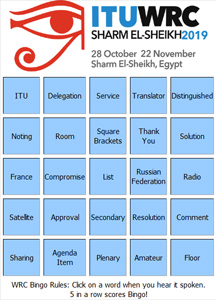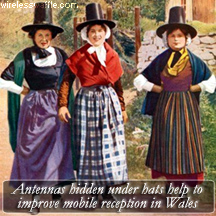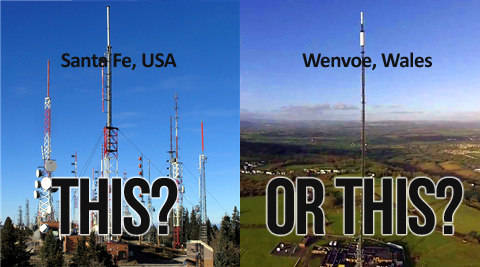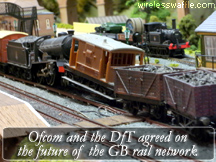Friday 15 November, 2019, 06:15 - Spectrum Management, Much Ado About Nothing
Posted by Administrator
Posted by Administrator
 Over 1000 delegates are currently slogging it out at the World Radiocomminication Conference taking place in Sharm El Sheikh, Egypt. The conference can be extremely tedious as various working groups sit in laborious meetings working out whether 'and' or 'or' should be used in a sentence.
Over 1000 delegates are currently slogging it out at the World Radiocomminication Conference taking place in Sharm El Sheikh, Egypt. The conference can be extremely tedious as various working groups sit in laborious meetings working out whether 'and' or 'or' should be used in a sentence.To try and help with the boredom, Wireless Waffle presents, ITU WRC Bingo.
The rules are very simple. Whilst sitting in a meeting, every time that a word on your bingo card is spoken, click on it and it will be illuminated. If you get 5 words in a row (vertically, horizontally, or diagonally) you have achieved BINGO! At this point, the rules require you to stand up and shout either 'bingo' or 'house' but perhaps you might wish, instead, to ask the chairman for the floor and quietly state:
Subject to confirmation by the sub-working group, and noting the necessary primary resolution, I resolve to believe that the correct terminology for that which is in front of me, is 'Bingo'!
add comment
( 440 views )
| permalink
| 



 ( 3 / 85193 )
( 3 / 85193 )




 ( 3 / 85193 )
( 3 / 85193 )
Thursday 21 February, 2019, 08:53 - 5G, Spectrum Management, Much Ado About Nothing
Posted by Administrator
Back in December of 2016, the UK Government's National Infrastructure Commission published its 'Connected Future' report. It recognised that:Posted by Administrator
government must take responsibility to secure our digital future ... Government must ensure we have the infrastructure in place to deliver 5G
Amongst the various proposals in the report, many are based on the recognition that 5G will require access to orders of magnitudes more base station sites than are currently deployed for 4G.
This makes a lot of sense. Local planning restrictions already hamper the roll-out of mobile services, not just because local councils think that cell sites are ugly, or even that they damage the environment or health, but the application procedure to get permission to install a site varies wildly from one council to another. Simplifying, harmonising and streamlining the process is essential if the UK, or indeed any country, is going to benefit from whatever it is that 5G is going to offer.
 It seems rather short-sighted then, that the Welsh Government is still pondering a change to what are know as Permitted Development Rights (PDR) to allow mobile operators to build masts with a height of 25 metres (82 feet) with reduced planning requirements. At present, in Wales, operators are only allowed to extend the height of their masts to 15 metres (50 feet), whereas in the rest of the UK, the limit is 25 metres.
It seems rather short-sighted then, that the Welsh Government is still pondering a change to what are know as Permitted Development Rights (PDR) to allow mobile operators to build masts with a height of 25 metres (82 feet) with reduced planning requirements. At present, in Wales, operators are only allowed to extend the height of their masts to 15 metres (50 feet), whereas in the rest of the UK, the limit is 25 metres. Wireless Waffle has previously discussed the relative merits of increasing transmitter power compared to increasing antenna height and demonstrated the importance of antenna height. In an area such as Wales where the difficulty in providing coverage is exacerbated by the hilly terrain, and where a large number of mobile 'not-spots' exist, antenna height is of even greater importance. The reluctance to increase the permitted tower height comes in stark contrast to a previous move by the Welsh Government to invest £150 million in trying to provide coverage in these not-spots.

There is no doubt a fear that higher masts will make the countryside look ugly or cluttered, but the counter-balancing effect is that taller masts, means fewer masts. Imagine how many TV transmitter towers there would need to be if their height was limited to 15 metres. If Wales is to rise out of the valleys in terms of mobile coverage, the Welsh Government needs to act quickly, i.e. before 5G comes along, to ensure that the existing not-spot problems are not further heightened (see what we did there?)
As they say in Wales: "Nid yw tegell llawn caws yn cael ei ddefnyddio i ffôn symudol gyda chalon wedi'i dorri."
Sunday 28 October, 2018, 09:38 - Much Ado About Nothing
Posted by Administrator
Posted by Administrator
 As it's that time of year again (which is to say late October), the time has come to give a plug to our ever growing list of One Hundred Halloween Hits. Whilst the list started out as just a hundred, it's now reached 130, so you are getting a bonus 30% free and for nothing. How good is that?
As it's that time of year again (which is to say late October), the time has come to give a plug to our ever growing list of One Hundred Halloween Hits. Whilst the list started out as just a hundred, it's now reached 130, so you are getting a bonus 30% free and for nothing. How good is that?Including such classic tracks as Thriller, Werewolves of London and Ghostbusters, if you are looking for the perfect playlist for your Halloween party this year, look, no further.
No, it's got nothing particularly to do with radio spectrum, or telecommunications but everyone needs a break, to let down their hair, put on a black cape, paint their face green and go from house to house demanding sweets (candy) from their neighbours occasionally don't they?
Thursday 30 August, 2018, 14:45 - Spectrum Management, Much Ado About Nothing
Posted by Administrator
Posted by Administrator
 Ofcom has published a report called "Advice to Government on improving rail passenger access to data services, Spectrum for trackside connectivity solutions and rail passenger data demand". In it, they examine the amount of data needed to supply connectivity to passengers and then which spectrum band is best suited to supply these needs.
Ofcom has published a report called "Advice to Government on improving rail passenger access to data services, Spectrum for trackside connectivity solutions and rail passenger data demand". In it, they examine the amount of data needed to supply connectivity to passengers and then which spectrum band is best suited to supply these needs.The amount of data that each passenger will be consuming each month is taken directly from Ofcom's "Mobile Data Strategy" which was published in 2016. These range from 50 to 200 Gbytes per month in 2025 depending on the scenario. The report assumes that 80% of this data is offloaded onto WiFi and that it will be a WiFi service that is provided on the train.
 If this is the case, the average user will consume between 40 and 160 Gbytes of WiFi data per month, which is 1.3 to 5.3 Gbytes per day. If we take Ofcom's figures that there will be between 600 and 1440 passengers on busy commuter trains, and that a typical commute on a train lasts 1 hour, then the total amount of data per hour consumed by all the passengers between 33 and 315 Gbytes. This, in turn, equates to a connectivity requirement of between 73 and 700 Mbps. Of course, this assumes that every passenger on the train uses the WiFi service that is provided, which is unlikely to be the case, especially (as Ofcom also notes) if the service requires a payment to connect to.
If this is the case, the average user will consume between 40 and 160 Gbytes of WiFi data per month, which is 1.3 to 5.3 Gbytes per day. If we take Ofcom's figures that there will be between 600 and 1440 passengers on busy commuter trains, and that a typical commute on a train lasts 1 hour, then the total amount of data per hour consumed by all the passengers between 33 and 315 Gbytes. This, in turn, equates to a connectivity requirement of between 73 and 700 Mbps. Of course, this assumes that every passenger on the train uses the WiFi service that is provided, which is unlikely to be the case, especially (as Ofcom also notes) if the service requires a payment to connect to.Having presumably done the same calculations, Ofcom has arrived at a requirement of between 400 Mbps and 3.6 Gbps, or roughly 5 times more. So either train journey in Ofcom's world are 5 times longer, or people on trains are 5 times more hungry for data than normal individuals.
 Based on these figures, Ofcom have assumed that a benchmark connectivity speed should be around 1 Gbps for trains. It has then gone on to analyse the various spectrum options, and decided that the only band that can deliver the necessary connectivity is the 26 GHz band, which is one of the bands being touted for future 5G services. It completely excludes, for example, the use of the 2.7 - 2.9 GHz band as it claims that this could only deliver 100 Mbps of connectivity (assuming that 40 MHz of it could be made available). It also discounts the 5.4 GHz band as this could only deliver 'a few hundred Mbps'.
Based on these figures, Ofcom have assumed that a benchmark connectivity speed should be around 1 Gbps for trains. It has then gone on to analyse the various spectrum options, and decided that the only band that can deliver the necessary connectivity is the 26 GHz band, which is one of the bands being touted for future 5G services. It completely excludes, for example, the use of the 2.7 - 2.9 GHz band as it claims that this could only deliver 100 Mbps of connectivity (assuming that 40 MHz of it could be made available). It also discounts the 5.4 GHz band as this could only deliver 'a few hundred Mbps'. There are, though, significant issues with the 26 GHz band:
- Coverage of a 26 GHz 'cell' is expected to be a few 100 metres only, which would mean tens of thousands of cells would be needed to cover the UK rail network.
- Trains run at up to 200 km/h, this places extreme demands on handovers if cells are close together, let alone dealing with Doppler shift and Rayleigh fading.
- The 26 GHz band has been identified as a 'pioneer' band for 5G services in Europe and is likely to be in high demand from mobile operators for their future mobile services.
 There is, however, a very simple solution to the whole problem. If we shrink the size of the rail network to be only a few hundred metres long, then the 26 GHz solution will work perfectly. This, perversely, seems to be the plan of the Department for Transport who allow companies such as Southern, Thameslink, Hull Trains and Northern Trains to implement new timetables that effectively reduce the rail network to set of toys, that can't convey passengers anyway. Bravo, Ofcom, for realising that the rail industry will be reduced to OO-gauge before long anyway.
There is, however, a very simple solution to the whole problem. If we shrink the size of the rail network to be only a few hundred metres long, then the 26 GHz solution will work perfectly. This, perversely, seems to be the plan of the Department for Transport who allow companies such as Southern, Thameslink, Hull Trains and Northern Trains to implement new timetables that effectively reduce the rail network to set of toys, that can't convey passengers anyway. Bravo, Ofcom, for realising that the rail industry will be reduced to OO-gauge before long anyway.
